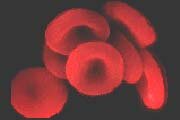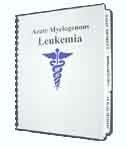 |
||
| HOME | ||
 |
||
| Acute Myelogenous Leukemia (AML) |
||
 |
||
| Other Leukemia Types (ALL / CLL / CML / HCL) |
||
 |
||
| Myelodysplastic Syndrome | ||
 |
||
| Symptoms and Diagnosis | ||
 |
||
| Leukemia Treatment Options | ||
 |
||
| " Chemotherapy | ||
 |
||
| " Blood Stem Cell Transplants | ||
 |
||
| " Radiation and Surgery | ||
 |
||
| " Chemo Side Effects | ||
 |
||
| " Clinical Trials Info | ||
 |
||
| " Coping with Leukemia | ||
 |
||
| " What to Ask Your Doctor | ||
 |
||
| Financial Assistance | ||
 |
||
| At Risk Jobs/Exposure | ||
 |
||
| Leukemia Resources | ||
 |
||
| Survivor's Story | ||
 |
||
| Leukemia News | ||
 |
||
|
Search for information:
|
||

|
Leukemia Cancer News - Return to Menu Rare but deadly side effects February 7, 2005 - My husband took Lamisil to treat toenail fungus. The fine print for this prescription drug noted that it might cause neutropenia. For my husband, it did. This led to MDS (myelodysplastic syndrome), which was followed by AML (acute myeloid leukemia) and his subsequent death. He had suffered with periodic flare-ups of toenail fungus and athlete's foot for most of his life. Neither of these conditions was life-threatening. Please tell your readers that even though the possibly serious side effects mentioned by drug companies might affect only 1% of users, they could be in that 1%. Ask if it is worth that chance. We are so sorry to hear of your husband's tragic death. Doctors don't always mention unusual but potentially life-threatening reactions. In rare cases, Lamisil may trigger serious blood disorders such as neutropenia, a lack of white blood cells. The drug can also damage the liver, and there have been deaths associated with this problem. This is a high price to pay to cure toenail fungus. Patients must always be informed of common side effects and also of symptoms that might be associated with rare but deadly adverse reactions. From Lamisil.com: Most patients tolerate treatment with Lamisil Tablets very well. However, like all prescription drugs, Lamisil Tablets may cause some side effects in some people. These side effects, as determined by three clinical studies, were mild and in general did not lead to discontinuation of treatment with Lamisil Tablets. The most commonly reported side effects were headache, which occurred in 12.9% of patients, gastrointestinal symptoms, including diarrhea (5.6%), upset stomach (4.3%), taste disturbances (2.8%), nausea (2.6%), abdominal pain (2.4%), flatulence (2.2%), rash (5.6%), itching (2.8%), hives (1.1%), and abnormalities in laboratory tests of liver enzymes (3.3%). In some cases, these complaints were no more frequent than in patients taking placebo (sugar pill). There is more information on www.Lamisil.com, but the page labeled "Patient Product Information did not have any mention of neutropenia. The is a mention found in a PDF file on the site: Feverfew & Cancer A daisy-like plant known as Feverfew, found growing wild across the British Isles, is the source of an agent that kills human leukaemia stem cells like no other single therapy, scientists at the University of Rochester Medical Center's James P. Wilmot Cancer Center have discovered. Their investigation is reported in the online edition of the journal Blood. It will take months before a useable, pharmaceutical compound can be made from parthenolide, the main component in Feverfew. However, UR stem cell expert Craig T. Jordan, Ph.D., and Monica L. Guzman, Ph.D., lead author on the Blood paper, say their group is collaborating with University of Kentucky chemists, who have identified a water-soluble molecule that has the same properties as parthenolide. The National Cancer Institute has accepted this work into its rapid access program, which aims to move experimental drugs from the laboratory to human clinical trials as quickly as possible. "This research is a very important step in setting the stage for future development of a new therapy for leukaemia," said Jordan. "We have proof that we can kill leukaemia stem cells with this type of agent, and that is good news." Parthenolide is the first single agent known to act on myeloid leukaemia at the stem-cell level, which is significant because current cancer treatments do not strike deep enough to kill mutant cells where the malignancy is born. In other words, even the most progressive leukaemia treatment, a relatively new drug called Gleevec, is effective only to a degree. It does not reach the stem cells, so, according to Jordan, "you're pulling the weed without getting to the root." Feverfew has been used for centuries as an herbal remedy to reduce fevers and inflammation, to prevent migraine headaches, and to ease symptoms from arthritis. A person with leukaemia, however, would not be able to take enough of the herbal remedy to halt the disease. Investigating stem cells that give rise to cancer is an urgent new initiative, as is identifying stem-cell treatments that might end the disease process. Jordan and Guzman are among only a handful of stem cell biologists nationwide who are specifically studying cancer stem cells. In recent years, scientists have identified cancer stems cells in blood cancers and in brain and breast tumours, although the idea that cancer stems cells exist has been around for at least 40 years. In the current study, the UR group began investigating Feverfew after other scientists showed that it prevented some skin cancers in animal models. Intrigued by the plant's anti-tumour activities, the UR team analysed how a concentrated form of parthenolide would act on the most primitive types of acute myelogenous leukaemia cells, chronic myelogenous leukaemia cells and normal cells. In laboratory experiments, they also compared how human leukaemia stem cells reacted to parthenolide, versus a common chemotherapy drug called cytarabine. The result: parthenolide selectively killed the leukaemia cells while sparing the normal cells better than cytarabine. Scientists believe parthenolide might also make cancer more sensitive to other anti-tumour agents. And, the UR group was able to demonstrate the molecular pathways that allow parthenolide to cause apoptosis, or cancer cell death, increasing the chances of developing a new therapy. The research is sponsored by grants from the Leukemia and Lymphoma Society, American Cancer Society and National Cancer Institute. Parents Blame Refinery For Children's Cancers VIDEO: Dana Kozlov reports. Jan 11, 2005 The parents held a meeting Tuesday night looking for answers. A color-coded map helps Tricia Krause track all of the children around Blue Island that have cancer. It is her mission, every since two of her kids were diagnosed with two different forms of it at a young age. According to my map, we have a significant higher level of leukemia, aplastic anemia and brain cancers in children and adults, Krause said. Krause believes environmental pollutants are to blame. One company under the microscope is the former Clark, now Premcor, refinery in Blue Island. The refinery is now closed. Illinois general investigator Matthew Dunn says Premcor had a troubled past and is the subject of two current lawsuits. One is filed about the Illinois Attorney Generals office for Historical Contamination. Dunn say there's is an investigation that may determine a possible link. The order is requiring a complete and thorough investigation for what remains out there from all of those various releases over the years, Dunn said. He spoke to three dozen concerned parents at the meeting all living near the site. They held it to gather more illness information. Many parents here have children who battled cancer and in some cases lost. It is these industries are putting polluting the air. Not only the air but the soil and the water. They need to be stopped, said Patrick Marinier, whose daughter, Donna, had leukemia but lived. There is no proof of a district link between them and any potential cancer cluster, and even Krause acknowledges it is difficult to prove scientifically No one from the company was available for comment. Dana Kozlov
|
|
|


